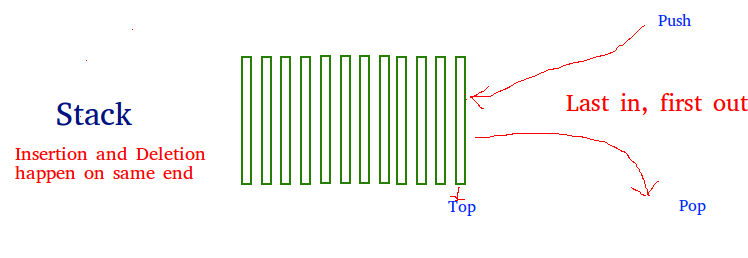Python stack list
Python stack list

Here's a comprehensive guide to using the stack module in Python:
What is a Stack?
A stack is a Last-In-First-Out (LIFO) data structure, where elements are added and removed from the top of the stack. Think of it like a deck of cards - you can add cards to the top of the deck and remove them one by one.
Creating a Stack in Python
To create a stack in Python, you can use the list class, which is a built-in data structure that allows you to add and remove elements. Here's how:
stack = []
Pushing Elements onto the Stack
To "push" an element onto the stack, simply append it to the end of the list using the append() method:
stack.append('A')
stack.append('B')
stack.append('C')
print(stack) # Output: ['A', 'B', 'C']
Popping Elements from the Stack
To "pop" an element from the stack, use the pop() method with no arguments (by default, it removes and returns the last element in the list):
popped_element = stack.pop()
print(popped_element) # Output: 'C'
print(stack) # Output: ['A', 'B']
Peeking at the Top Element
You can "peek" at the top element of the stack without removing it by using the [-1] indexing:
top_element = stack[-1]
print(top_element) # Output: 'B'
Stack Operations
Here are some common operations you can perform on a stack:
Push: Add an element to the top of the stack. Pop: Remove and return the top element from the stack. Peek: Get the top element without removing it. IsEmpty: Check if the stack is empty.Using Stacks in Real-World Scenarios
Stacks are useful in many real-world scenarios, such as:
Parsing expressions: When evaluating an expression, you need to follow the order of operations (parentheses, exponents, multiplication and division, addition and subtraction). Implementing recursive algorithms: Recursion is all about breaking down problems into smaller sub-problems and solving them. Managing memory: In computer science, a stack can be used to manage memory allocation and deallocation.Conclusion
In this article, we covered the basics of working with stacks in Python. We created a stack using a list, pushed elements onto it, popped elements from it, peeked at the top element, and performed some common operations. Stacks are a fundamental data structure in computer science, and understanding how to work with them is essential for any programming enthusiast.
Resources
Python Documentation: list W3Schools: Python List TutorialChallenge
Create a program that implements a stack using a list, and then use it to solve the following problem:
Write a function that takes an integer n as input, and returns the n-th Fibonacci number. A Fibonacci sequence is defined recursively: each element is the sum of the two preceding elements, starting from 0 and 1.
Bonus
Here's a bonus challenge for you:
Create a program that implements a stack using a deque (double-ended queue), and then use it to solve the following problem:
Write a function that takes an integer n as input, and returns the n-th permutation of the string "ABC". The permutations should be generated in lexicographic order.
Is stack the same as list in Python?
I'm happy to help!
No, stack and list are not exactly the same thing in Python. While they share some similarities, they serve distinct purposes.
A stack is a linear data structure that follows the Last In First Out (LIFO) principle. It's essentially an ordered collection of items where the most recently added item is the first one to be removed. This means that you can only access the top element on the stack, and once it's removed, it's gone forever.
In Python, you don't have a built-in data structure called a "stack." However, you can create your own stack using a list or a collections.deque object. When you push an item onto the stack (or add an element to the end of the list/deque), you're essentially creating a new layer in the stack. When you pop an item from the stack (or remove the last element from the list/deque), you're taking the most recently added item and moving it to the front of the stack.
Here are some key differences between using a list as a stack vs. implementing your own stack:
Insertion and removal efficiency: When using a list as a stack, inserting or removing an element from the middle of the list requires shifting all the subsequent elements. This can be slower than simply pushing or popping an item in a proper stack implementation. Space complexity: A real stack typically has a constant space complexity since it only stores the most recent additions and removals. In contrast, using a list as a stack can lead to poor memory usage if you're constantly adding and removing elements.On the other hand, a list (or array) in Python is an ordered collection of items that supports efficient indexing, slicing, and manipulating elements. Lists are particularly useful when you need to store and access data in a specific order or perform random access operations.
To illustrate the difference between using a list as a stack and implementing your own stack:
# Using a list as a stackstack = []
stack.append(1) # O(1) time complexity
stack.append(2)
print(stack.pop()) # O(1) time complexity
Implementing a stack using a listclass Stack:
def init(self):
self.stack_list = []
def push(self, item):
self.stack_list.append(item)
def pop(self):
if not self.is_empty():
return self.stack_list.pop()
else:
raise ValueError("Stack is empty")
stack = Stack()
stack.push(1)
stack.push(2)
print(stack.pop()) # O(1) time complexity
In summary, while you can use a list as a stack in Python, it's not the most efficient or scalable solution. Implementing your own stack using a list or a collections.deque object provides better control over insertion and removal operations, making it more suitable for applications that require LIFO behavior.





























